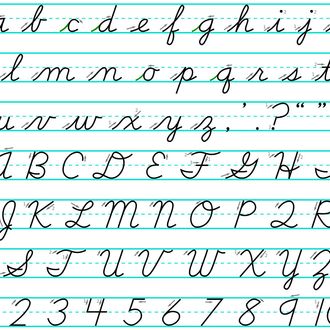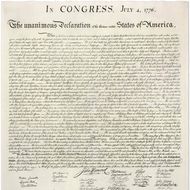
The aesthetics of American conservatism often seem to prize the old-fashioned or anachronistic. Tea-partiers commune at rallies wearing tricorn hats; right-wingers make pilgrimages to Colonial Williamsburg to ask actors why Obama hates the Constitution; Ronald Reagan built his political brand on cowboy stylings borrowed from Hollywood’s version of the Old West.
Now the dying art of cursive handwriting has emerged as a vigorous rallying point among some on the right. On a scale from 1 to Repealing Obamacare, making sure schoolchildren continue to learn fancy handwriting may not take top priority, but there it was last week listed on the front page of the New York Times — alongside tax cuts, abortion restrictions, and the right to carry a gun into a bar or restaurant — as a signature achievement of the Republicans who dominate the statehouse in North Carolina. When I called state representative Chris Malone, a sponsor of the new law, he explained the appeal: “For kids today, having a little discipline, having to know something, and be drilled on something is probably good for them.”
Similar legislation has been introduced and passed in states across the country, for the most part spearheaded by Republicans. According to figures compiled by the National Conference of State Legislatures, there has been new GOP-led cursive legislation introduced this year in Idaho, Indiana, Kentucky, and both Carolinas, plus an unsuccessful bill sponsored by a Democrat in Mississippi. Deep-red states Texas, Oklahoma, and Louisiana already have laws on the books, as do West Virginia and solidly blue California.
The defense of cursive is not a strictly partisan issue — many Democratic lawmakers in the North Carolina General Assembly voted for Representative Malone’s bill, for instance — but the balance of enthusiasm does seem to tip rightward. Intrigued by the politics of handwriting pedagogy, I called Morgan Polikoff, an education-policy expert at the University of Southern California who has prominently endorsed a shift away from cursive instruction, to ask about his hate mail.
“When I get hate mail — hate e-mail — about cursive, it’s mostly from conservatives,” he told me. “The hate mail I get from liberals is that we’ve decimated the curriculum and there’s no more beauty in schooling. And cursive is one of those beautiful skills that allow you to read notes from your grandmother. The argument you get from conservatives is more ‘How are we going to be able to read the Constitution and the Declaration of Independence?’”

This summer, the issue gained a poster child. In the televised trial of the Florida neighborhood watchman George Zimmerman for the death of young Trayvon Martin, a teenaged witness, shown a letter on the stand, testified, “I can’t read cursive.” Right-wing pundits described her as, for example, the “emblematic star of an ill-educated generation raised on TV and pop culture, disrespectful of their elders, marginally literate and incapable of exercising the duties of responsible citizenship.”
Neat cursive worksheets may symbolize to some the Beaver Cleaver era of American youth, when conformity was much less complicated than it is today. “Penmanship education is about following instructions to reproduce standardized models,” Tamara Plakins Thornton, the author of Handwriting in America: A Cultural History, told me. “It stands in sharp contrast to the expression of individuality. In conservative times, that kind of expression is seen as socially dangerous — permissiveness, leading to deviance and immorality.”
In the last few decades, school districts across the country have sought to eliminate any instruction time spent outside the scope of high-stakes standardized testing. Once you’ve tossed aside art and sports in the scramble to survive, the suggestion that cursive — an artifact of an era when we didn’t do nearly all of our formal writing on keyboards and keypads — has become an unaffordable luxury starts to make a lot of sense.
But demanding cursive instruction also stands, to some on the right, as a challenge to a (liberal) education bureaucracy. Many of the latest round of save-cursive proposals are shots fired against Common Core, a controversial set of national curriculum standards set to be adopted in 45 states for the upcoming school year. (The program does not mandate cursive instruction.) Since 2009, when an education consulting agency started designing the standards, conservative critics have nursed suspicions of a creeping power grab. “In its essence the Common Core cheapens our children’s education,” the blogger Hayden K. Smith wrote in a post for FreedomWorks, “and further erodes the nation’s tradition of Federalism.”
When state legislatures convened in the spring, with the adoption of the Common Core fast approaching, conservatives quickly took up the cause of cursive, citing wide-ranging rationales. “Without sounding overly paranoid,” wrote the blogger Sanford Horn in the Indianapolis Conservative Examiner, “when our antiquated power grid fails, and it will, pen and paper will once again rule the day.”
Representative Malone, for his part, shrugged off suggestions that his campaign to defend the teaching of loopy script is driven by political ideology. “I didn’t feel like I was picked on, having to learn cursive,” he told me. “And I don’t think it’ll cause anybody any real angst.”





























